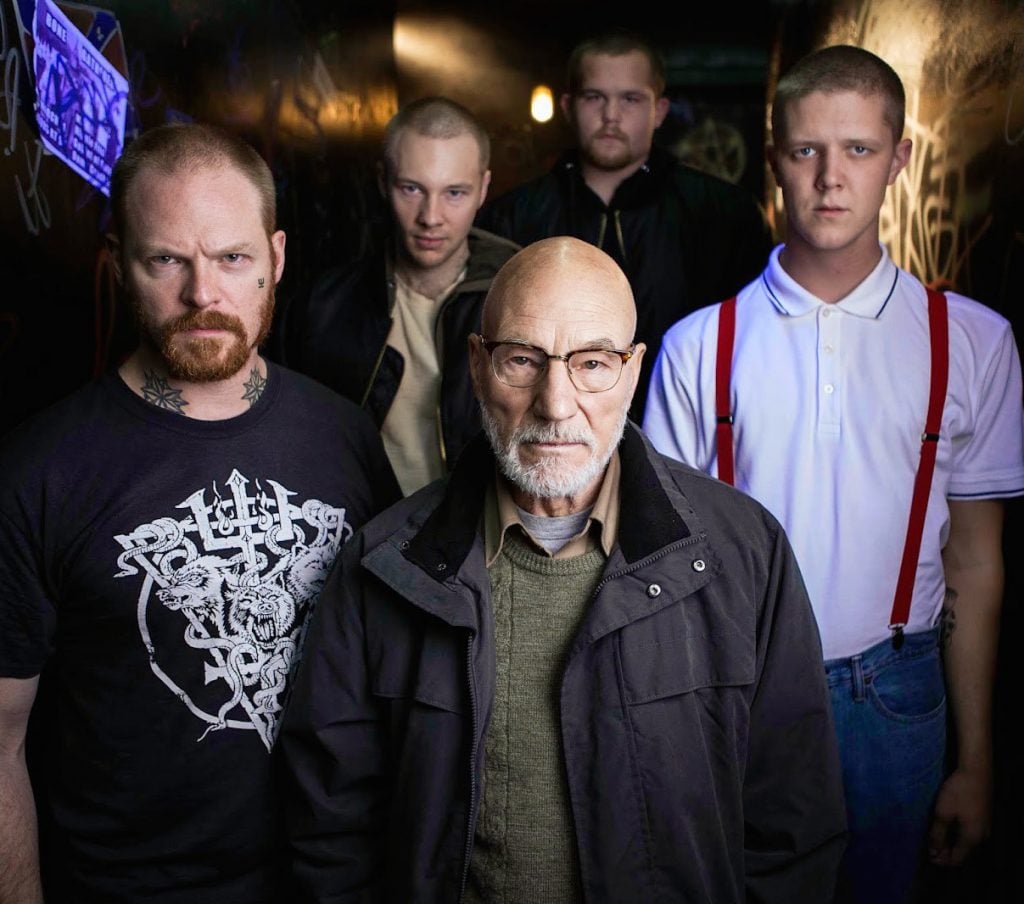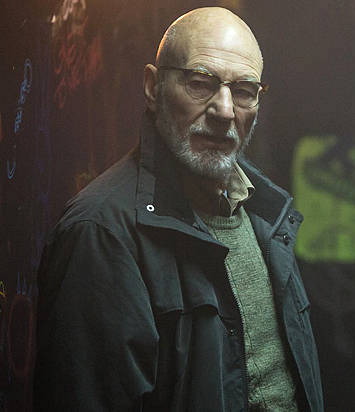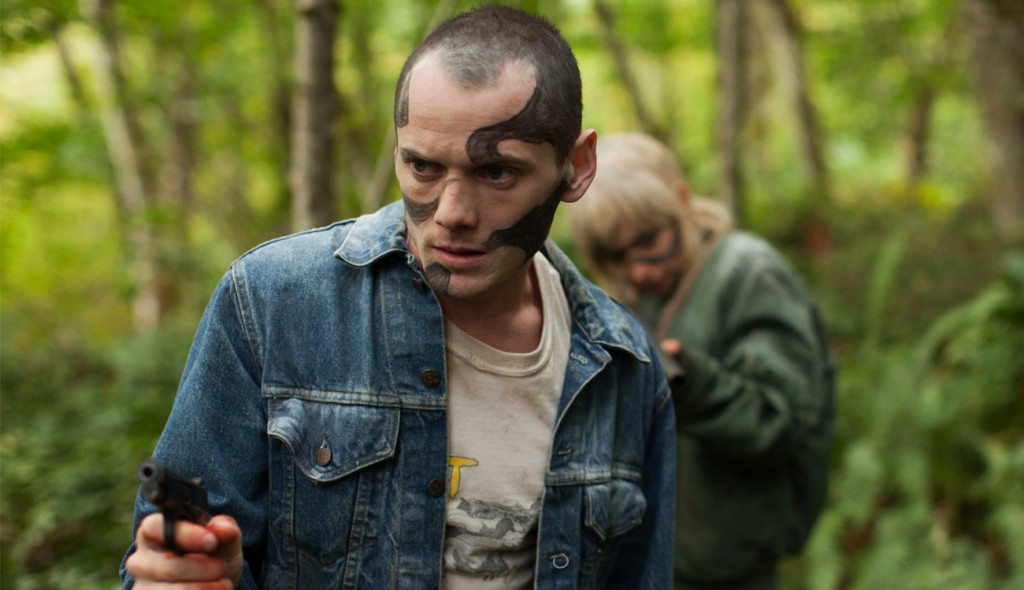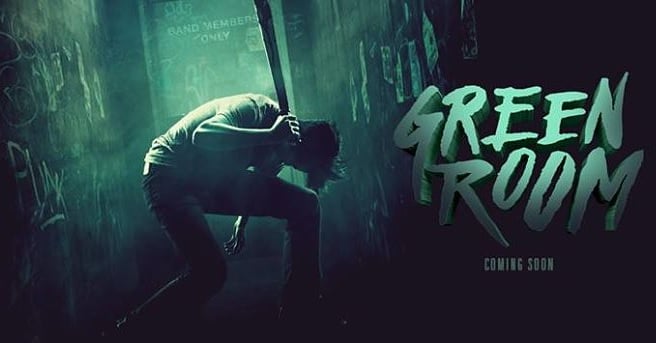Music and movies have always been connected. From the piano players from the silent movie era to the epic scores created by John Williams and Hans Zimmer to the amazing soundtracks of films like ‘Guardians of the Galaxy’, ‘Empire Records’, or ‘Pulp Fiction’, films throughout history have taken their cues from various tunes. But when it comes to the new thriller ‘Green Room‘, it seems like Jeremy Saulnier quite literally took a page out of the punk rock playbook. Like the genre itself, the writer and director made his third feature film hard, fast, and brutal, which resulted in one of the most must-see horror movies of the year so far.
In ‘Green Room’, a band called The Ain’t Rights are wrapping up a long and unsuccessful tour. But when they unexpectedly get booked in the backwoods of Oregon, their final gig escalates into a much more sinister situation when they witness something that they shouldn’t have. From there, it’s an onslaught of violence featuring skinheads, vicious fight dogs, and an eerily methodical club owner played by the incomparable Patrick Stewart as the band tries to escape with their lives.
Recently, just ahead of the film’s wide release this weekend, the filmmaker sat down with us for an interview and spoke to us about how he crafted his latest movie to reflect his days in the punk/hardcore scene and the aggressive nature of the music that lent itself perfectly to his story. Through fusing punk rock and hardcore with genre cinema, Saulnier wanted to bring “the look and the feel and the texture of punk rock, hardcore, and metal, but then sort of let it all go and to become a traditional action thriller”. But his research to capture all of that began in his youth.
 “I was into the punk rock and hardcore scene for most of my childhood,” the filmmaker recalled. “Peripherally of course. I was a skateboarder in suburban Virginia and was just introduced to punk rock and thought it was the perfect soundtrack for such a physical expression. It wasn’t until my buddies got their drivers licenses in the early 90s that I got to experience what a real show was like. That was intoxication. It was another outlet that was a very physical expression, a very individual expression, and very inclusive. So that was what I was trying to capture [in ‘Green Room’]. I’m not even sure a lot of people in the scene would even remember me because I was more of an observer. Certainly I got mixed up in the pit a lot, but I was really trying to absorb what was going on and it was great to finally archive my knowledge and my experience in ‘Green Room’ cinematically because this was all pre-internet and I didn’t have much of an archive. I had a few slides of the bands and some photo prints, but nothing that would really stand the test of time, so this is my way of remembering everything.”
“I was into the punk rock and hardcore scene for most of my childhood,” the filmmaker recalled. “Peripherally of course. I was a skateboarder in suburban Virginia and was just introduced to punk rock and thought it was the perfect soundtrack for such a physical expression. It wasn’t until my buddies got their drivers licenses in the early 90s that I got to experience what a real show was like. That was intoxication. It was another outlet that was a very physical expression, a very individual expression, and very inclusive. So that was what I was trying to capture [in ‘Green Room’]. I’m not even sure a lot of people in the scene would even remember me because I was more of an observer. Certainly I got mixed up in the pit a lot, but I was really trying to absorb what was going on and it was great to finally archive my knowledge and my experience in ‘Green Room’ cinematically because this was all pre-internet and I didn’t have much of an archive. I had a few slides of the bands and some photo prints, but nothing that would really stand the test of time, so this is my way of remembering everything.”
Of course, in typical punk rock fashion, Saulnier made it a point not to try too hard to make the movie anything more than what it was, which is why he avoided extraneous subplots, false character arcs, needless band drama, or too much exposition in the story. “I think that because of the nature of using the music and trying to extract the energy, it wasn’t clinical. The aggression, the texture, and the blunt-force conflict of the movie. To indulge and getting bogged down in minutia and trade crafts and procedure that is not expert or is not seamless and perfect and well-choreographed. A lot of work went into making this film seem so haphazard like it’s unfolding in real time and it’s not all planned out to a swiss watch plan. There was no death order planned. I certainly had an idea where the film had to go and it naturally went there, but the fun part about this was surprising myself and not adhering to any kind of formula and not trying too hard to make this punk. It was a full immersion into this world then letting it go so as to have it be an environment and not so much a subject matter. That was I think liberating and makes it more authentic. When it’s vetted by people who are in the music scene, it’s embraced because it doesn’t try too hard.”

Under the grizzled punk rock surface of this movie, it also had a lot to say about being who you are no matter how you appear to the world. It started with an innocent conversation about dessert island bands. If you could only listen to one band’s discography while you were trapped on a dessert island, which band would you pick? The Ain’t Rights talk about this idea at various points in the movie and at first many of them pick some iconic punk bands. But later on, their answers change to show that young people tend to put up a front to fit in so that they’re not labeled a “poser”. This was definitely something that Saulnier (whose dessert island band is Black Sabbath) meant to explore with his story.
“That’s how I felt. Absolutely. And the more I talked to people who are just world renowned anchors of the hardcore scene or the punk scene, we all have our own secret desert island band and rarely are they punk bands. It really is about an experience and you can love all kinds of music. I remember hearing what people listen to when they go home because I think after the experience of a show when my ears are ringing, I don’t want to hear any music. I maybe wanna drink a six-pack with my buds and break bottles or when I was real young, go home and cuddle with my mom. And then you feel like, ‘Is everyone hardcore and punk around the clock?’ I certainly am not. I want to go train my dog in the backyard or build a fine scale model in 1/72nd scale. There are other things that I want to do. And so we are not our projected selves and that’s okay. You can argue that it’s as punk as anything else to admit that you’re not punk. [Laughs]”
Of course, that’s not always the case. Some people in certain scenes can become gatekeepers or they turn it into a contest. We talked a little bit about how detrimental this mentality of being a poser could be.“When I’m there at a hardcore show, I feel like there’s no place that I’d rather be. It’s just a matter of when it becomes a contest like who has the best vinyl collection, who can drop the most names, who can go to the most shows. That’s when you just get tired of it,” he said.  “And it’s not just this particular scene. All scenes are the same in that regard. Some people want to regulate it, some people want to educate people on the history of the scene, some people just want to go and party. To each their own. That’s what’s so great about these scenes, especially hardcore and punk. Under one roof you have so many different kinds of people. It embraces diversity. Even in ‘Green Room’, there’s a lot of different music genres. A lot of hardcore, but a lot of metal too and a lot of beautiful score. It’s important. When you get older, the currency isn’t cool. It’s authenticity and that’s a big theme in this movie.”
“And it’s not just this particular scene. All scenes are the same in that regard. Some people want to regulate it, some people want to educate people on the history of the scene, some people just want to go and party. To each their own. That’s what’s so great about these scenes, especially hardcore and punk. Under one roof you have so many different kinds of people. It embraces diversity. Even in ‘Green Room’, there’s a lot of different music genres. A lot of hardcore, but a lot of metal too and a lot of beautiful score. It’s important. When you get older, the currency isn’t cool. It’s authenticity and that’s a big theme in this movie.”
Before our time was up, we had to address the amazing cast that was assembled for ‘Green Room’. Not only did it star the legendary Patrick Stewart in a role that was very much against type for him, but younger stars like Anton Yelchin, Alia Shawkat, and Imogen Poots really had a chance to shine in a project that most of them haven’t really had a chance to explore. “The cool thing is that it was the subject matter that attracted everybody. I had a rule that I wasn’t going to knock down doors just to convince people to play roles. I want them to be naturally gravitating towards the material. This offered the 25 and under crowd a rare opportunity to experience a film and portray characters that would be primarily physical in their performance. They love it when you don’t give them a ton of backstory and monologues and exposition. They had to do this physically and they relished the opportunity to do that. For [Yelchin, Shawkat, and Poots] to helm an action movie is very rare. They’re very young and this is putting them way out of their depth, so they were cast against type without skill sets and trade craft coming in handy.”
However, as many will recall, Yelchin isn’t exactly a stranger to action. He appeared in ‘Star Trek’ and ‘Star Trek Into Darkness’ as Chekov. Likewise, Stewart is known for his roles in ‘X-Men’ and ‘Star Trek’, so with that level of nerd cred on set, did any of that affect the vibe while they were filming? “It’s definitely important that we shield our set from fan culture. It’s hard not to know outside of this universe that we’re creating the franchise associations like Anton Yelchin and Patrick Stewart,” the filmmaker explained. “They carry that with them wherever they go, so with Patrick, it was just about ignoring all that and treating him like any other actor that hones his craft and maybe shows a new side. The marketing part is fun because you can talk about the crossover with the franchises with the X-Men and ‘Star Trek’ and all that. But on set, we were very particular about not worrying about anything outside of the world. Not that we all went method the whole time, but it was exhausting emotionally and we had to keep a certain continuity with the characters and develop them very quickly on set with not a lot of rehearsal time.”

Finally, to come full circle, we talked a bit about the movie’s soundtrack. One of the most memorable scenes is when the band opens their set with the unforgettable Dead Kennedys hit “Nazi Punks F*ck Off”. It was a really ballsy move, especially considering where they were performing, so it was definitely a scene that the audience will remember when the credits roll. In fact, without that song, ‘Green Room’ probably wouldn’t have worked properly. “The soundtrack for this, we had to be responsible,” explained Saulnier. “We had a few temp track that we lost, but ‘Nazi Punks’ was the key song that was written into the script. It was a cover of the Dead Kennedys, so when they gave us permission during preproduction, it was huge. I don’t know what I would do without that song. The whole script would implode as far as I’m concerned, so it was great to have the support from the community.”
But what about some other punk rock institutions like The Misfits, Bad Religion, Rancid, or Black Flag? As the director said, a few songs had to go for budgetary reasons, but he revealed that the songs that he couldn’t picture the final product without the songs that they went with in the end. “There was a point where we had a bigger band that was blasting through the PA, but it was more expensive, so we replaced it with this band Midnight. They’re a really cool metal band and looking back I wouldn’t even go back to the other one. Things line up. It was the only track that could’ve worked in that scene. There’s a little bit of maneuvering when you’re finalizing a soundtrack as far as the financial side, but a lot of this was done through friends of friends that we reached out to. Associates that are still in DC where I was in the punk scene. Consultants that were just friends of friends. Most of the soundtrack is comprised of people that I know from high school and the songs they wrote or mutual friends that have bands that fed us this great supply of music that we could license.”
At the end of the day, music and movies are both very collaborative art forms. However, the collaboration doesn’t end when production wraps. Both require an audience to enjoy them to finish the process. So with that in mind, be sure to catch Jeremy Saulnier’s insanely tense and unapologetically brutal ‘Green Room’ starring Anton Yelchin, Alia Shawkat, Imogen Poots, Macon Blair, Mark Webber, and Patrick Stewart in a theater near you because that would totally be punk rock.
Despite being a “professional writer”, Ben likes run-on sentences and puns far too much. Also, his dessert island band/artist would probably either be Elvis Presley, Michael Jackson, or Reel Big Fish. For more of his attempts at being funny and the occasional insightful thought, follow him on Twitter and Instagram.

